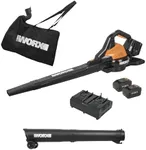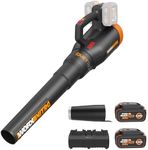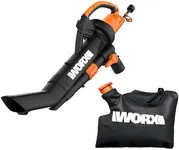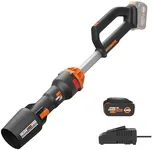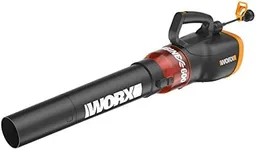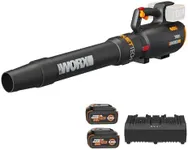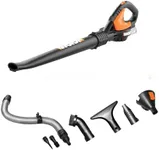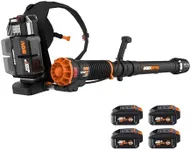Buying Guide for the Best WORX Leaf Blowers
When choosing a leaf blower, it's important to consider your specific needs and the features that will best suit your yard and tasks. Leaf blowers come in various types and with different specifications that can significantly impact their performance and usability. Understanding these key specs will help you make an informed decision and ensure you get the best product for your needs.Power SourceLeaf blowers can be powered by electricity (corded or cordless) or gas. Electric models are generally lighter, quieter, and require less maintenance, making them ideal for small to medium-sized yards. Cordless models offer more mobility but have limited battery life. Gas-powered blowers are more powerful and suitable for larger areas but are heavier, noisier, and require more maintenance. Choose based on the size of your yard and your preference for mobility and maintenance.
Airflow (CFM)CFM stands for Cubic Feet per Minute and measures the volume of air the blower can move. Higher CFM means the blower can move more leaves and debris at once. For small yards and light tasks, a CFM of 200-400 is sufficient. For medium to large yards or heavier tasks, look for a CFM of 400-700. For professional or very large areas, a CFM above 700 is ideal. Consider the size of your yard and the type of debris you need to move when choosing the right CFM.
Air Speed (MPH)MPH stands for Miles Per Hour and measures the speed at which the air is expelled from the blower. Higher air speed can help move stubborn debris and wet leaves. For light tasks and small yards, an air speed of 100-150 MPH is adequate. For medium to large yards, look for 150-200 MPH. For heavy-duty tasks or professional use, an air speed above 200 MPH is recommended. Match the air speed to the type of debris and the conditions in your yard.
WeightThe weight of the leaf blower affects how easy it is to handle and use for extended periods. Lighter models (under 8 pounds) are easier to maneuver and suitable for small to medium tasks. Medium-weight models (8-12 pounds) offer a balance of power and ease of use, ideal for medium to large yards. Heavier models (over 12 pounds) are more powerful but can be tiring to use for long periods. Consider your physical strength and the duration of use when choosing the weight.
Noise LevelLeaf blowers can be quite noisy, which can be a concern for you and your neighbors. Noise levels are measured in decibels (dB). Electric models are generally quieter, with noise levels around 60-70 dB, while gas models can exceed 90 dB. If noise is a concern, look for models with lower dB ratings or consider electric blowers. Check local regulations as some areas have noise restrictions for outdoor equipment.
Battery Life (for cordless models)For cordless leaf blowers, battery life determines how long you can use the blower before needing to recharge. Battery life is usually measured in minutes of runtime. For small yards, a battery life of 15-30 minutes may be sufficient. For medium to large yards, look for 30-60 minutes of runtime. For larger areas or extended use, consider models with interchangeable batteries or longer runtimes. Match the battery life to the size of your yard and the duration of your tasks.
ErgonomicsErgonomics refers to how comfortable and easy the leaf blower is to use. Features like padded handles, adjustable speeds, and balanced weight distribution can make a big difference in comfort, especially for extended use. Look for models with ergonomic designs if you plan to use the blower for long periods or have physical limitations. Test the blower if possible to ensure it feels comfortable and easy to handle.
